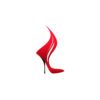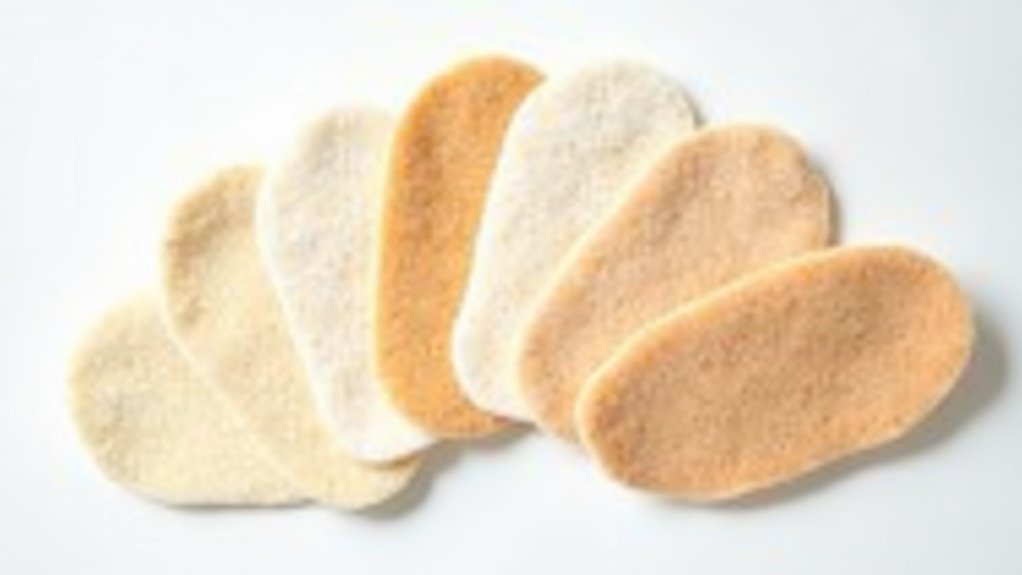There may be products. Products are independently selected by our editors. We may earn an affiliate commission from the links with no charge to you, example: as Amazon Affiliate.
You’ll find that premium heel liners can transform loose-fitting shoes into perfectly snug footwear when you select the right type and install them correctly. The best heel liners feature strong adhesives that work even in sweaty conditions, high-quality materials like patented gel or memory foam for comfort, and designs specific to your shoe type. Look for moisture-wicking properties in athletic shoes, thicker cushioning for heels, and thinner profiles for flats. While price points vary, investing in quality materials often leads to better longevity. Our podiatrist-approved picks will help you step confidently into better-fitting shoes.
Key Takeaways
- Strong adhesives combined with moisture-resistant materials are crucial for heel liners to maintain grip during extended wear.
- Premium materials like patented gel, microfiber, or memory sponge provide optimal comfort while ensuring liners stay securely in place.
- Proper installation on clean, dry surfaces with firm pressure across the entire surface significantly improves adhesive longevity.
- Breathable, moisture-wicking materials prevent sweat accumulation that can compromise adhesive effectiveness and cause slippage.
- Activity-specific designs ensure better grip, with thicker cushioning for heels and thin, grippy options for athletic footwear.
Heel Pads and Inserts for Loose Shoes
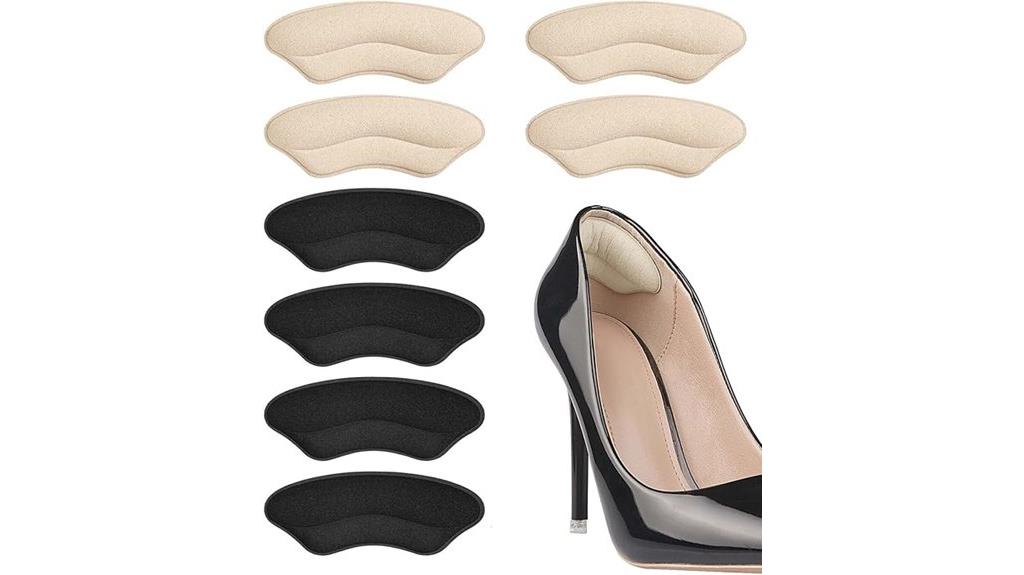
If you’re dealing with shoes that feel a bit too roomy, heel pads and inserts offer an effective solution for a more secure fit. These cushioned accessories prevent your heels from slipping while providing comfort and stability in oversized footwear.
You’ll find these pads feature a user-friendly peel-and-stick application with strong adhesion that lasts. They work best in shoes that are half to one size too large, especially when worn without socks. The balanced combination of softness and firmness ensures they’ll stay put without feeling bulky or uncomfortable.
While they’re highly effective for most users, you’ll want to avoid using them in properly fitting shoes as they may create unwanted tightness. For optimal results, make sure to properly prepare the shoe surface before applying the pad, and consider that thicker socks might affect their performance.
Best For: People with slightly oversized shoes seeking a comfortable and secure fit, particularly those who wear shoes without socks.
Pros:
- Strong, long-lasting adhesive that keeps pads securely in place
- Provides both cushioning and stability without feeling bulky
- Easy peel-and-stick application process
Cons:
- May not work effectively when worn with thick socks
- Can create uncomfortable tightness if used in properly fitting shoes
- Some users report issues with sharp edges causing discomfort
Heel Pads and Inserts for Loose Shoes
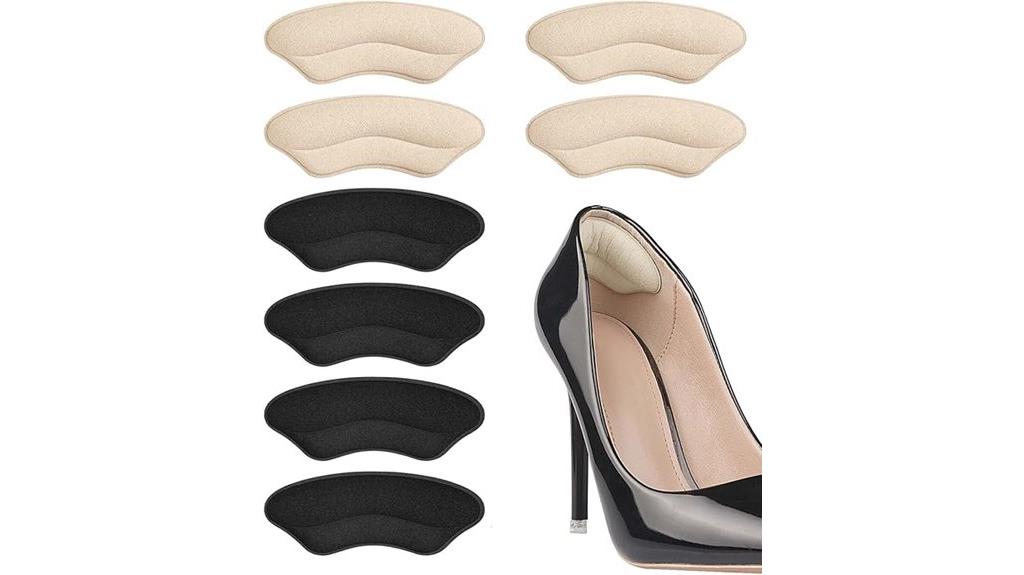
Heel pads and inserts offer a practical solution for anyone struggling with loose-fitting shoes that are a half to full size too big. These cushioned accessories provide both comfort and stability while preventing your heels from slipping out of your shoes.
You’ll find these pads are easy to install with their peel-and-stick application, and they’ll stay firmly in place when properly applied. The cushions strike an ideal balance between softness and firmness, ensuring your feet remain comfortable without feeling bulky. They’re particularly effective when you’re wearing shoes without socks, though you might need to readjust them if you switch to thicker hosiery.
While they work wonders for oversized shoes, don’t use them in properly fitting footwear as they may create unwanted tightness. Most users report high satisfaction levels and continue to purchase them for their loose-fitting shoes.
Best For: People who need to make slightly oversized shoes (half to one size too large) fit more securely and comfortably.
Pros:
- Easy peel-and-stick application with excellent adhesion
- Provides both comfort and stability while preventing heel slippage
- High-quality cushioning that doesn’t feel bulky
Cons:
- May need readjustment when wearing different sock thicknesses
- Some users report issues with sharp edges causing discomfort
- Not suitable for properly fitting shoes as they can create excessive tightness
Foot Petals Women’s Back of Heel Cushion Inserts
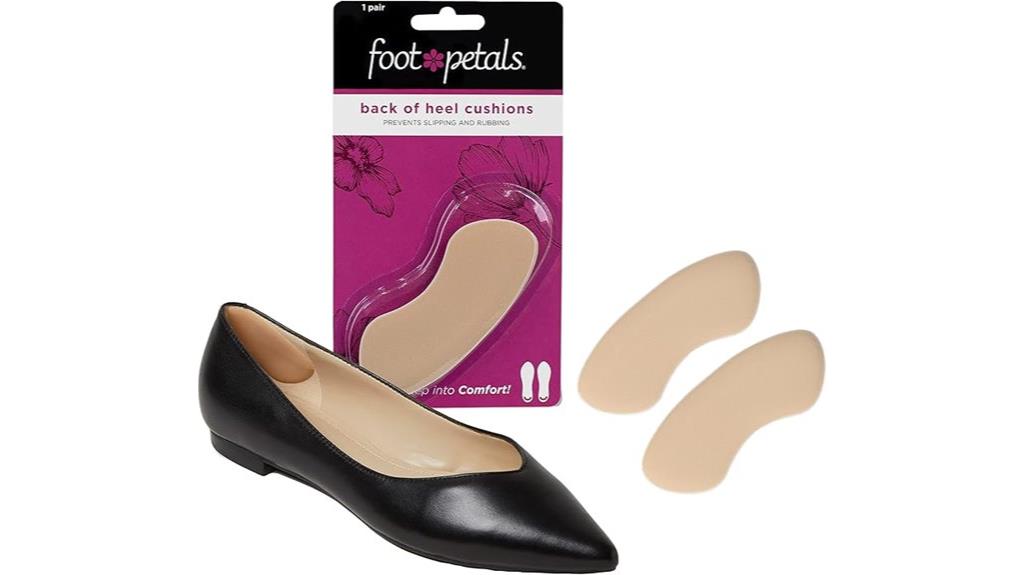
Women seeking relief from shoes that slip or rub against their heels will find comfort in Foot Petals Back of Heel Cushion Inserts. These cushions feature patented shock-absorbing gel technology that contours to your foot while providing 3-dimensional pressure distribution and flexible support.
You’ll appreciate how easy they are to use – simply clean the shoe surface, peel off the adhesive backing, and press firmly in place. They’re versatile enough for all your footwear, from high heels to flats and boots. While some users report issues with adhesive longevity, many have successfully revived unwearable shoes with these inserts.
The gel cushioning won’t flatten over time, helping prevent blisters and sores while improving the fit of slightly oversized shoes. They’re especially helpful during the break-in period for new shoes, making your favorite styles more comfortable to wear.
Best For: Women seeking comfort solutions for shoes that slip or cause heel discomfort, particularly those breaking in new footwear or dealing with slightly oversized shoes.
Pros:
- Patented gel technology provides effective shock absorption and pressure distribution
- Easy to apply and can be used in various shoe types from heels to flats
- Helps prevent blisters and sores while improving overall shoe fit
Cons:
- Some users report issues with adhesive durability and effectiveness
- May leave residue on shoes when removed
- Thickness may not provide enough support for some users’ needs
Sof Sole Heel Liner Cushions for Improved Shoe Fit and Comfort, 2 Pair
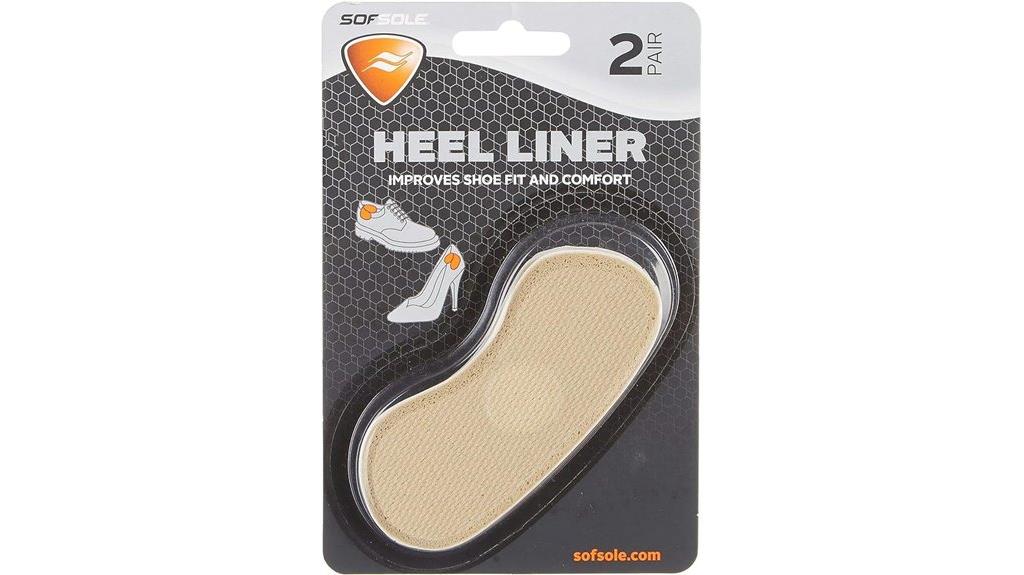
Looking for a reliable solution to loose-fitting shoes? The Sof Sole Heel Liner Cushions offer an affordable fix with two pairs of foam cushions designed to prevent heel slippage and enhance comfort.
These natural-colored liners feature excellent grip texture and comfortable cushioning that won’t cause blisters or irritation. At just 3.74 x 1.57 x 0.01 inches, they’re slim enough to fit most shoes while providing the right amount of thickness for a snug fit. You’ll find they work best on leather shoes, though some users suggest additional adhesive might be needed for certain materials.
For around $5, you’re getting two pairs of heel liners that can transform your loose shoes into comfortable, well-fitting footwear. While the adhesive’s effectiveness varies, many users praise these cushions for their durability and ability to secure shoes that are slightly too big.
Best For: Anyone looking to improve the fit of slightly loose shoes or seeking additional heel comfort, especially those with leather footwear who need a budget-friendly solution.
Pros:
- Provides effective grip texture to prevent heel slippage
- Includes two pairs of cushions at an affordable price point
- Slim design offers comfortable cushioning without causing blisters
Cons:
- Adhesive may not stick well to all shoe materials
- May require additional gluing for long-term use
- Some users report inconsistent durability of the cushions
Heel Cushion Liners for Big Shoes (6 Pairs)
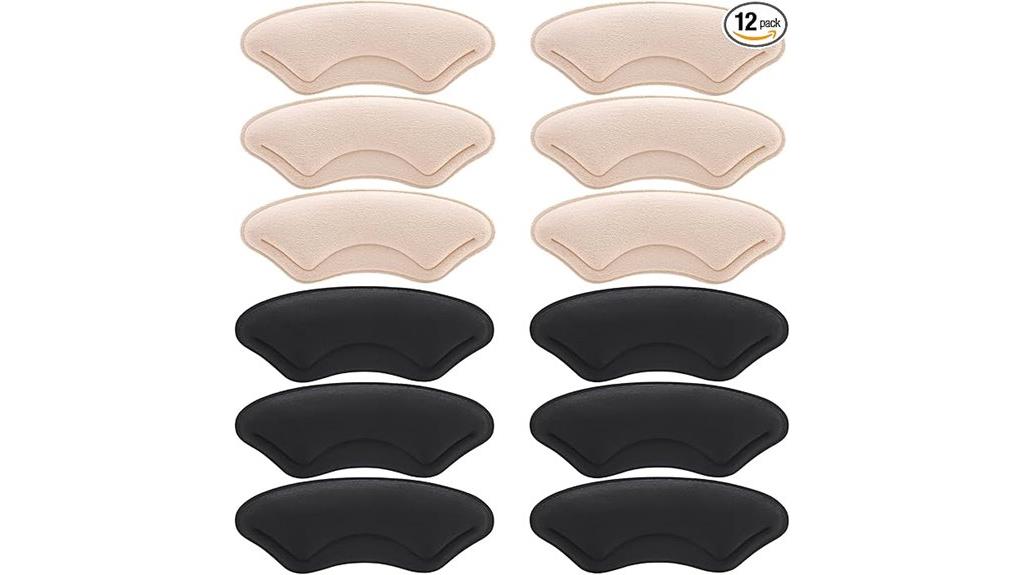
The perfect solution awaits anyone struggling with loose-fitting shoes or heel discomfort. These versatile heel cushion liners come in a value pack of six pairs (three black, three beige) and feature a durable microfiber and memory sponge construction that’s both breathable and sweat-absorbing.
You’ll appreciate how easy these liners are to apply – simply peel and stick them to your shoe’s heel area. They’re designed with high-sticky double-sided tape that won’t leave residue when removed. Whether you’re dealing with high heels, sneakers, or dress shoes that are slightly too big, these liners effectively prevent slipping while providing relief from heel pain, blisters, and plantar fasciitis. The practical 4D design works well for both men’s and women’s footwear, making them a smart choice for any shoe in your closet.
Best For: People who need to adjust loose-fitting shoes, prevent heel slippage, or seek relief from heel pain and blisters in various types of footwear.
Pros:
- Versatile design works with multiple shoe types and styles
- Easy to apply and remove without leaving residue
- Comes with 6 pairs in two colors for extended use
Cons:
- May not provide enough thickness for very loose shoes
- Effectiveness can vary depending on shoe material and fit
- Adhesive strength might decrease with prolonged use or sweating
Heel Grips Liner Cushions for Loose Shoes (4 Pairs)
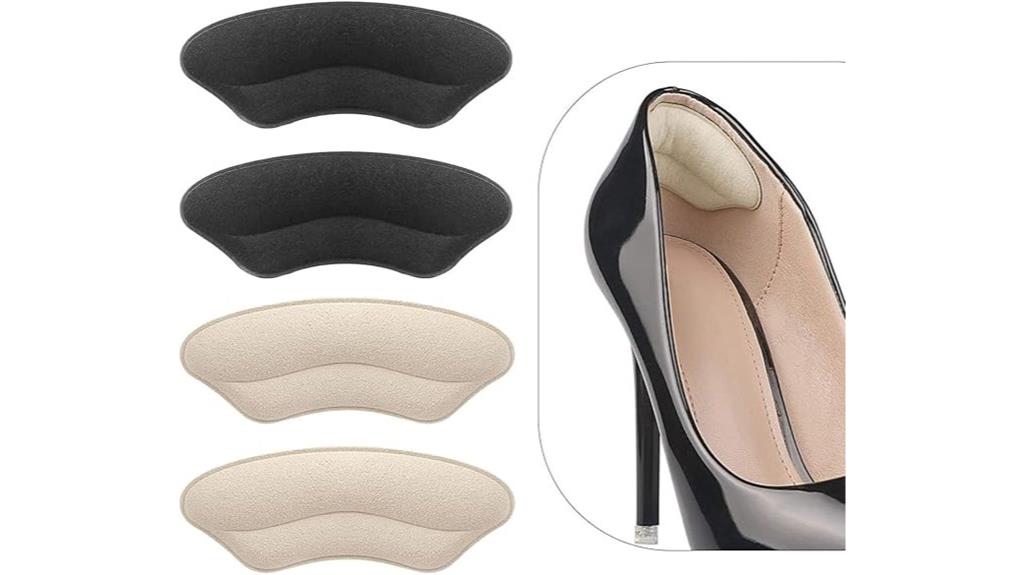
Loose-fitting shoes become instantly more wearable with these versatile heel grip cushions, which come in four pairs of both pale apricot and black colors. Made from breathable suede material, these self-adhesive liners are easy to apply – just peel and stick them to your shoe’s back.
You’ll find these cushions work particularly well if your shoes are a half-size too big or have a loose fit. They’re perfect for various footwear, from high heels to loafers, and help prevent blisters while providing essential comfort during extended wear. While they may flatten over time, you can easily reapply them when needed.
The cushions are ideal for those with wide toe boxes or anyone needing extra support while walking. Though they’re slightly thick, which might affect fit, they come with a 30-day refund policy for your peace of mind.
Best For: Individuals who need to improve the fit of slightly loose shoes, particularly those who wear heels or dress shoes that are a half-size too big.
Pros:
- Easy self-adhesive application that works on various shoe types
- Effectively prevents heel slippage and blister formation
- Comes in two colors (pale apricot and black) with multiple pairs for different shoes
Cons:
- May flatten over time and require reapplication
- Thickness might make some shoes too tight
- Not ideal for those seeking ultra-thin heel grip solutions
Dr.Foot Heel Grips and Cushion Inserts with Shoe Horn
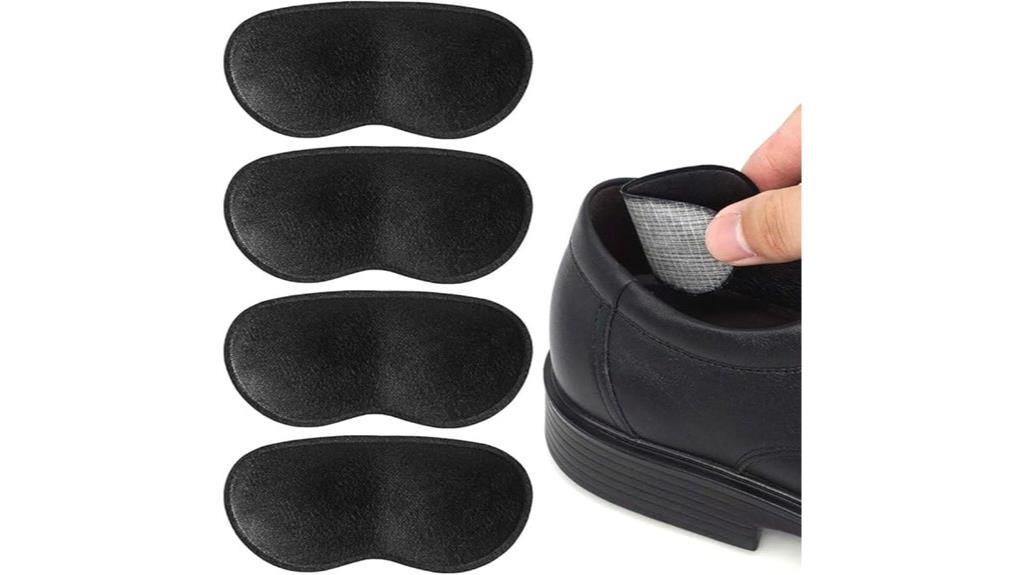
Busy professionals seeking reliable heel protection will appreciate Dr.Foot’s Heel Grips and Cushion Inserts. These ergonomically designed cushions come with a shoe horn and feature super sticky CROWN #513 double-sided tape that keeps them firmly in place, even in sweaty conditions.
You’ll find these versatile grips work well in various footwear, from dress shoes to hiking boots. At 3.3 inches long and 1.4 inches wide, they’re sized to prevent slipping and blisters while improving shoe fit. The soft foam topped with microsuede provides excellent anti-slip protection and follows your heel’s natural contours.
While the cushions may show wear after several months of use, they effectively relieve heel pain and enhance comfort in loose-fitting shoes. If you’re not satisfied, Dr.Foot offers a risk-free guarantee and will work with you to find solutions.
Best For: Office workers and active individuals who need reliable heel protection and improved shoe fit across various footwear types.
Pros:
- Strong adhesive backing stays secure even in sweaty conditions
- Versatile fit works with multiple shoe types from dress shoes to hiking boots
- Effectively prevents heel slipping and blisters while providing cushioned comfort
Cons:
- May develop wear holes after several months of regular use
- Limited size options with only one standard dimension available
- Adhesive strength might make removal and repositioning difficult
Factors to Consider When Choosing Heel Liners
When you’re shopping for heel liners, you’ll need to evaluate several key features to find the perfect fit for your shoes. Consider the material’s cushioning quality and adhesive strength, as these factors directly impact comfort and how long the liners will stay in place. You’ll also want to match the liner’s size, thickness, and design with your specific shoe type and how often you plan to wear them.
Material and Cushioning Quality
Understanding heel liner materials and cushioning quality is essential for finding the perfect fit for your shoes. When evaluating options, you’ll want to focus on materials that offer both comfort and durability. Premium heel liners often feature patented gel technology or microfiber construction, providing targeted shock absorption where you need it most.
The thickness of your liner plays a crucial role in how it performs. If you’re dealing with loose shoes, you’ll benefit from thicker cushioning that fills excess space while providing maximum comfort. For tighter footwear, opt for thinner liners that won’t create unwanted pressure points. Look for breathable materials that help manage moisture and prevent blister formation during extended wear.
The most effective heel liners incorporate high-sticky double-sided tape that maintains its grip through regular use. You’ll also want to ensure the materials are flexible enough to conform to your foot’s natural shape. This adaptability helps distribute pressure evenly across your heel while maintaining proper support. The right combination of these material qualities will ensure your heel liners remain functional and comfortable throughout their lifespan.
Adhesive Strength and Durability
The right adhesive strength can make or break your heel liner’s performance, regardless of how well-designed its cushioning may be. When you’re investing in heel liners, you’ll want to ensure they feature a strong adhesive that won’t give up halfway through your day, potentially leading to uncomfortable shifting and painful blisters.
Look for heel liners with moisture-resistant adhesives that maintain their grip even when your feet start sweating. This is particularly important if you’ll be wearing them during exercise or in warm weather. You’ll also need to consider how the adhesive interacts with your specific shoe material – what works perfectly on leather might not stick as effectively to fabric or synthetic surfaces.
Before applying your heel liners, you’ll need to properly prepare the surface of your shoes. Make sure they’re clean and completely dry to maximize the adhesive’s effectiveness. Keep in mind that even the highest-quality adhesives can deteriorate over time, so you might need to replace your heel liners periodically to maintain optimal performance. Consider this when evaluating the product’s overall value and deciding how many pairs to purchase.
Size and Thickness Options
Choosing the right size and thickness for your heel liners can significantly impact their effectiveness and comfort level. When selecting heel liners, you’ll need to consider both your shoe type and specific fit requirements to ensure optimal performance.
If you’re dealing with slightly oversized shoes, you might want to opt for thicker liners that provide substantial cushioning and help fill excess space. However, if you’re just looking to prevent minor slipping or add a touch of comfort, ultra-thin liners will serve your needs without making your shoes feel too tight.
You’ll find that heel liners come in various dimensions to match different shoe styles. For dress shoes, you might prefer slimmer profiles that won’t alter the fit dramatically, while athletic shoes can accommodate thicker options for enhanced shock absorption. When you’re between shoe sizes, specific half-size liners can provide the perfect adjustment.
Remember to assess your primary goal – whether it’s blister prevention, size adjustment, or comfort enhancement. If you’re prioritizing cushioning, choose thicker pads, but ensure your shoes have adequate space. For minimal fit refinements, thinner options will suffice while maintaining your shoes’ original comfort level.
Shoe Type Compatibility
Since different shoes serve distinct purposes, matching your heel liners to specific shoe types plays a crucial role in maximizing comfort and effectiveness. You’ll want to consider whether you’re shopping for high heels, flats, sneakers, or boots, as each style requires specific liner features to perform optimally. For instance, high heels often need thicker cushioning at pressure points, while athletic shoes may benefit from moisture-wicking materials with enhanced grip.
Before making your selection, check the liner’s compatibility with your shoe’s material. Some adhesives work better on leather surfaces, while others are specially formulated for synthetic materials or fabric. If you’re looking to outfit multiple pairs of shoes, consider versatile options that can adapt to various footwear styles. However, be mindful that thicker liners might feel uncomfortable in snug-fitting shoes, even if they work perfectly in roomier ones.
For activity-specific footwear, prioritize liners designed for your intended use. Runners should opt for shock-absorbing options, while dancers might prefer thin, grippy liners that won’t compromise their movements. This targeted approach ensures you’ll get the most benefit from your heel liners.
Intended Wear Duration
Duration plays a vital role when selecting heel liners, as your intended wear time will influence which features matter most. If you’re planning to use heel liners daily, you’ll need products made with robust materials that can handle constant pressure and friction without losing their shape or effectiveness. Look for options specifically designed for long-term wear, featuring industrial-strength adhesives and resilient cushioning.
For those who frequently switch between different shoes, consider investing in reusable heel liners that maintain their sticking power across various footwear styles. These versatile options can save you money while ensuring consistent comfort. If you’ll be wearing your shoes for extended periods, especially in humid conditions, opt for liners with superior adhesion that won’t budge when exposed to moisture.
Special occasions call for a different approach. If you’re only wearing certain shoes occasionally, you can choose lighter, less permanent heel liners. These temporary solutions provide the comfort you need without permanently altering your shoe’s fit or requiring the same level of durability as daily-wear options.
Moisture and Sweat Resistance
The ability to manage moisture and sweat directly impacts how long your heel liners will perform effectively. When you’re wearing shoes throughout the day, your feet naturally produce sweat, which can create an environment where bacteria and fungi thrive if not properly managed. That’s why it’s crucial to choose heel liners with superior moisture-wicking capabilities.
Look for heel liners made from breathable materials that actively draw sweat away from your feet. The best options incorporate moisture-wicking technology that keeps your feet dry and comfortable, even during extended wear. You’ll want to pay special attention to the material’s thickness and composition, as these factors influence how well the liner handles perspiration.
Don’t forget to consider anti-slip features in conjunction with moisture resistance. When your feet sweat, poorly designed liners can shift around, but those with anti-slip properties will stay firmly in place. This combination of moisture control and stability not only prevents uncomfortable sliding but also reduces your risk of developing blisters and other friction-related issues that can make wearing shoes unbearable.
Price vs. Quantity Value
When shopping for heel liners, understanding the relationship between price and quantity can help you make a cost-effective decision. Look for multipair packs that offer a lower cost per unit, as these typically provide better value than single-pair options. You’ll want to calculate the price per pair to compare different brands and package sizes effectively.
While it’s tempting to choose the lowest-priced option, consider the materials and features that affect longevity and performance. High-quality gel or foam liners might cost more initially but could save you money if they last longer than cheaper alternatives. Pay attention to the adhesive strength, as liners that stay put longer won’t need frequent replacement.
Before making your final decision, check customer reviews to ensure you’re getting good value for your money. Users often share how long the liners lasted and whether they lived up to their price point. If premium features like superior moisture-wicking or exceptional cushioning align with your needs, spending a bit more on well-reviewed products could be worth the investment. Remember that the best value isn’t always the lowest price, but rather the optimal balance of cost, quality, and durability.
Installation and Maintenance Needs
Making the most of your heel liner investment depends heavily on proper installation and ongoing care. Before applying your heel liners, you’ll need to thoroughly clean the shoe’s surface to ensure optimal adhesion. This simple preparation step can make the difference between liners that stay put and those that peel away prematurely.
Installation itself is straightforward – just peel and stick – but don’t rush this crucial step. Press firmly across the entire surface to activate the adhesive properly. While most heel liners are designed for easy removal without leaving residue, you’ll want to position them correctly the first time to maintain maximum stickiness.
To extend your heel liners’ lifespan, you’ll need to perform basic maintenance. Some liners benefit from occasional gentle cleaning to reactivate their adhesive properties. Keep an eye on how your liners are performing – if you notice them flattening or losing their grip, it’s time for replacement. Regular monitoring helps prevent discomfort and ensures you’re always getting the support you need. Remember, even the highest-quality heel liners require proper care to maintain their effectiveness over time.
Frequently Asked Questions
Can Heel Liners Be Used in Sandals or Open-Back Shoes?
You can use heel liners in sandals and open-back shoes, but you’ll need adhesive-backed styles specifically designed for these types of footwear to ensure they stay securely in place.
How Often Should Heel Liners Be Replaced?
Time waits for no heel liner, and you’ll need to replace yours every 3-6 months, depending on wear and tear. Watch for signs like peeling, lost adhesion, or thinning material.
Do Heel Liners Work for Children’s Shoes?
You can use heel liners in children’s shoes to prevent slipping and improve fit, but make sure they aren’t too thick. Choose ones specifically designed for kids’ smaller feet and footwear.
Can Heel Liners Help With Sweaty Feet Issues?
With 3% of Americans suffering from hyperhidrosis, you’ll find heel liners can help manage sweaty feet by absorbing moisture and providing an extra barrier between your skin and shoe material.
Are Heel Liners Safe to Use With Orthopedic or Diabetic Shoes?
You can safely use heel liners with orthopedic or diabetic shoes, but you’ll want to consult your doctor first to ensure they won’t interfere with your prescribed footwear’s therapeutic benefits.
Conclusion
Just like finding the perfect dance partner, choosing the right heel liner is about harmony and support. You’ll want a liner that moves with you, not against you. With studies showing that up to 80% of people wear ill-fitting shoes, investing in quality heel liners isn’t just about comfort – it’s about protecting your feet. Consider these top picks to transform your loose shoes into perfect fits.
